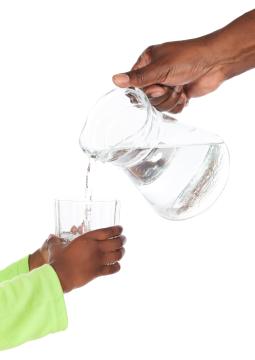Manganese
What is manganese?
Manganese is a naturally occurring mineral found in the environment and some foods.
Small amounts of manganese are needed to form healthy bones, produce glucose, and heal wounds.
How can I be exposed to manganese?
People are exposed to manganese from food, air, and water.
People are exposed to the most manganese through food and manganese-containing vitamins. Grains, beans, and nuts, and tea have naturally high levels of manganese.
People can be exposed to low levels of manganese in air from factories that use or make products with manganese, vehicle exhaust, and tobacco smoke.
People can be exposed to manganese from drinking water as manganese is naturally present in Wisconsin's groundwater.
How can manganese affect my health?
Studies show that exposure to high levels of manganese can affect the nervous system, impact reproduction, and damage kidneys.
People over the age of 50, infants less six months, people with certain medical conditions (iron-deficiency anemia, liver disease) are the most sensitive to these effects.
How can I protect myself and my family from manganese?
Too much manganese can affect our health. We can take steps to reduce how much manganese we are exposed to from our drinking water.
Community water systems test for manganese at least once every nine years. If the level of manganese in the water is high, the system will issue a do not drink advisory.
- At manganese levels equal to or greater than 300 micrograms per liter (μg/L), the system will issue an advisory for sensitive groups.
- At manganese levels equal to or greater than 1,000 μg/L, the system will issue an advisory for the general population.
If your system issues a do not drink advisory for sensitive groups:
- People over the age of 50 should immediately use an alternative source of water for drinking and preparing foods that take up a lot of water (like rice, oatmeal, and gelatin).
- Options include bottled water, water from a public system without violations, and water from a private well without issues.
- Use a different source of water to make baby formula and for babies to drink.
- It is ok to use the water for bathing, brushing teething, and washing dishes.
If your system issues a do not drink advisory for the general population:
- Everyone should use a different source of water for drinking and making foods that that take up a lot of water.
- It is ok to use the water for bathing, brushing teething, and washing dishes.
In both cases, the Wisconsin Department of Natural Resources (DNR) will work with the water system to reduce the manganese level.
Our Manganese in Public Water fact sheet, P-45103B has these steps in printable format.
Private well users should test for manganese if their water is brown or rust color, stains the faucets, sinks, or laundry, or has an off-taste or odor.
- Testing using a Wisconsin certified lab.
- Households with pregnant people and young children may be eligible for free testing through their local health department.
Take action If the manganese level is equal to or greater than 300 micrograms per liter (µg/L).
- People over the age of 50 should immediately use an different source of water for drinking and preparing foods that take up lot of water (like rice, oatmeal and gelatin).
- Options include include bottled water, water from a well without issues, and water from a public system without violations.
- Use a different source of water to make baby formula and for babies to drink.
- It is ok to use the water for bathing, brushing teething, and washing dishes.
- Retest your well to verify to results.
If the manganese level is still high:
- Everyone should use an alternative source of water for drinking and preparing foods that take up a lot of water.
- Work to find a long-term solution. Options include installing a certified treatment device and drilling a new well.
- Our Water Treatment Devices for Private Well Contaminants fact sheet, P-45012 (PDF) has information on certified treatment devices for manganese.
- The DNR well compensation grants provide funds to address public health hazards in private wells.
Our Manganese in Private Wells fact sheet, P-45103A has these steps in printable format.
Who regulates manganese in Wisconsin?
The Wisconsin Department of Natural Resources (DNR) regulates how much manganese can be released into groundwater in Wisconsin and how much can be served by public water systems.
Related topics
- Our groundwater standards page has information on how Wisconsin's groundwater standards are set, DHS' role in the process, and a summary of the current and recommended standards including manganese.
- The Wisconsin Department of Natural Resource's DNR's manganese and drinking water page has additional information on steps that public and private waters users can take if manganese is in their drinking water.
- The Wisconsin Groundwater Coordinating Council's Annual Report to the Legislature summarizes the actions that state agencies to address groundwater issues including manganese.
- The University of Wisconsin - Steven Point Well Water Quality Interactive Viewer shows water quality data from a variety of contaminants (including manganese) at a county, township, and section levels.
- The Agency for Toxic Substances and Disease Registry (ATSDR) ToxFAQs page has more information on manganese exposure routes and health effects.
Questions? Can't find what you're looking for?
Contact us at dhsenvhealth@dhs.wisconsin.gov

